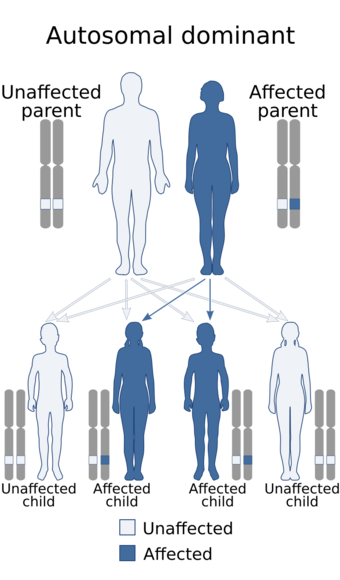Medicine:Boomerang dysplasia
| Boomerang dysplasia | |
|---|---|
| Other names | Dwarfism with short, bowed, rigid limbs and characteristic facies |
 | |
| Boomerang dysplasia has an autosomal dominant pattern of inheritance. | |
Boomerang dysplasia is a lethal form of osteochondrodysplasia[1] known for a characteristic congenital feature in which bones of the arms and legs are malformed into the shape of a boomerang.[2] Death usually occurs in early infancy due to complications arising from overwhelming systemic bone malformations.[1]
Osteochondrodysplasias are skeletal disorders that cause malformations of both bone and cartilage.
Presentation
Prenatal and neonatal diagnosis of boomerang dysplasia includes several prominent features found in other osteochondrodysplasias, though the "boomerang" malformation seen in the long bones is the delineating factor.[2]
Featured symptoms of boomerang dysplasia include: dwarfism[3] (a lethal type of infantile dwarfism caused by systemic bone deformities),[4] underossification (lack of bone formation) in the limbs, spine and ilium (pelvis);[1] proliferation of multinucleated giant-cell chondrocytes (cells that produce cartilage and play a role in skeletal development - chondrocytes of this type are rarely found in osteochondrodysplasias),[5] brachydactyly (shortened fingers) and micromelia (undersized, shortened bones).[2]
The characteristic "boomerang" malformation presents intermittently among random absences of long bones throughout the skeleton, in affected individuals.[3][6] For example, one individual may have an absent radius and fibula, with the "boomerang" formation found in both ulnas and tibias.[6] Another patient may present "boomerang" femora, and an absent tibia.[3]
Cause
Mutations in the Filamin B (FLNB) gene cause boomerang dysplasia.[1] FLNB is a cytoplasmic protein that regulates intracellular communication and signalling by cross-linking the protein actin to allow direct communication between the cell membrane and cytoskeletal network, to control and guide proper skeletal development.[7] Disruptions in this pathway, caused by FLNB mutations, result in the bone and cartilage abnormalities associated with boomerang dysplasia.[citation needed]
Chondrocytes, which also have a role in bone development, are susceptible to these disruptions and either fail to undergo ossification, or ossify incorrectly.[1][7]
FLNB mutations are involved in a spectrum of lethal bone dysplasias. One such disorder, atelosteogenesis type I, is very similar to boomerang dysplasia, and several symptoms of both often overlap.[8][9]
Genetics
Early journal reports of boomerang dysplasia suggested X-linked recessive inheritance, based on observation and family history.[3] It was later discovered, however, that the disorder is actually caused by a sporadic genetic mutation fitting an autosomal dominant genetic profile.[8]
Autosomal dominant inheritance indicates that the defective gene responsible for a disorder is located on an autosome, and only one copy of the gene is sufficient to cause the disorder, when inherited from a parent who has the disorder.[10]
Boomerang dysplasia, although an autosomal dominant disorder,[8] is not inherited because those afflicted do not live beyond infancy.[1] They cannot pass the gene to the next generation.[citation needed]
Diagnosis
Treatment
See also
References
- ↑ 1.0 1.1 1.2 1.3 1.4 1.5 "Mutations in FLNB cause boomerang dysplasia". Am J Med Genet 42 (7): e43. 2005. doi:10.1136/jmg.2004.029967. PMID 15994868.
- ↑ 2.0 2.1 2.2 "Prenatal diagnosis of boomerang dysplasia". Am J Med Genet A 122 (2): 148–154. 2003. doi:10.1002/ajmg.a.20239. PMID 12955767.
- ↑ 3.0 3.1 3.2 3.3 "Boomerang dysplasia". Am J Med Genet 36 (4): 440–443. 1990. doi:10.1002/ajmg.1320360413. PMID 2202214.
- ↑ "New forms of neonatal death dwarfism. Report of 3 cases". Pediatr Radiol. 10 (3): 155–160. 1981. doi:10.1007/BF00975190. PMID 7194471.
- ↑ "Giant-cell chondrocytes in a male infant with clinical and radiological findings resembling the Piepkorn type of lethal osteochondrodysplasia". Am J Med Genet 68 (3): 342–346. 1997. doi:10.1002/(SICI)1096-8628(19970131)68:3<342::AID-AJMG17>3.0.CO;2-T. PMID 9024569.
- ↑ 6.0 6.1 "Boomerang dysplasia". Br J Radiol 58 (688): 369–371. 1985. doi:10.1259/0007-1285-58-688-369. PMID 4063680.
- ↑ 7.0 7.1 "Filamin B mutations cause chondrocyte defects in skeletal development". Hum Mol Genet 16 (14): 1661–1675. 2007. doi:10.1093/hmg/ddm114. PMID 17510210.
- ↑ 8.0 8.1 8.2 "Atypical skeletal changes in otopalatodigital syndrome type II: phenotypic overlap among otopalatodigital syndrome type II, boomerang dysplasia, atelosteogenesis type I and type III, and lethal male phenotype of Melnick-Needles syndrome". Am J Med Genet 73 (2): 132–138. 1997. doi:10.1002/(SICI)1096-8628(19971212)73:2<132::AID-AJMG6>3.0.CO;2-W. PMID 9409862.
- ↑ "Lethal bone dysplasia in a fetus with manifestations of Atelosteogenesis type I and Boomerang dysplasia". Am J Med Genet 47 (4): 1086–1091. 1993. doi:10.1002/ajmg.1320470731. PMID 8291529.
- ↑ "Boomerang dysplasia". 2016-02-22. http://ghr.nlm.nih.gov/condition/boomerang-dysplasia.
External links
| Classification | |
|---|---|
| External resources |
 |

